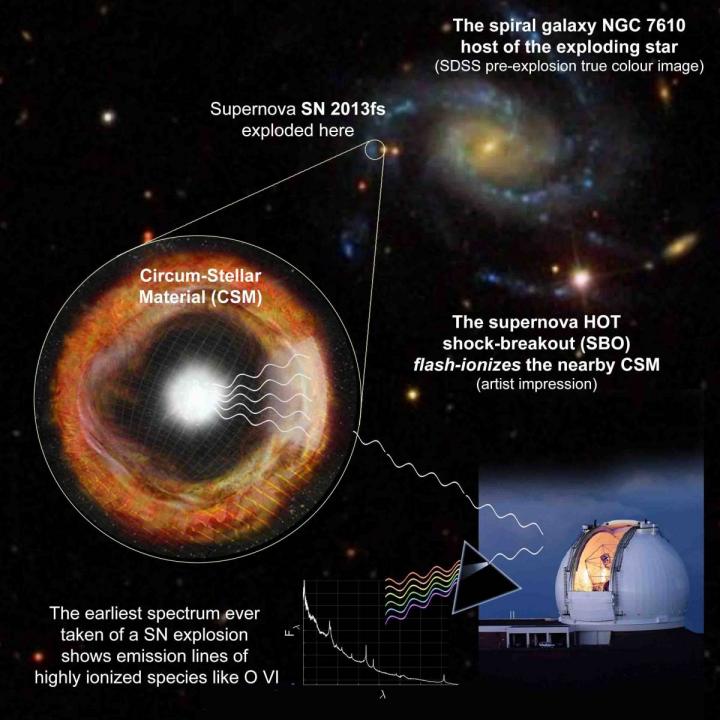
Credit: Weizmann Institute of Science
In the most common type of supernova, the iron core of a massive star suddenly collapses in on itself and the outer layers are thrown out into space in a spectacular explosion. New research led by Weizmann Institute of Science researchers shows that the stars that become so-called core-collapse supernovae might already exhibit instability for several months before the big event, spewing material into space and creating a dense gas shell around themselves. They think that many massive stars, including the red super-giants that are the most common progenitors of these supernovae, may begin the process this way.
This insight into the conditions leading up to core collapse arose from a unique collaboration called the Palomar Transient Factory, a fully automated sky survey using the telescopes of the Palomar observatory in southern California. Astrophysicists halfway around the globe, in Israel, are on call for the telescope, which scans the California night sky for the sudden appearance of new astronomical "transients" that were not visible before – which can indicate new supernovae. In October, 2013, Dr. Ofer Yaron, in the Weizmann Institute's Particle Physics and Astrophysics Department, got the message that a potential supernova had been sighted, and he immediately alerted Dr. Dan Perley who was observing that night with the Keck telescope in Hawaii, and NASA's Swift Satellite. At Keck, the researchers soon began to record the spectra of the event. Because they had started observing only three hours into the blast, the picture the team managed to assemble was the most detailed ever of the core collapse process. "We had x-rays, ultraviolet, four spectroscopic measurements from between six and ten hours post-explosion to work with," says Yaron.
In a study recently published in Nature Physics, Yaron, Weizmann Institute researchers Profs. Avishay Gal-Yam and Eran Ofek, and their teams, together with researchers from the California Institute of Technology and other institutes in the United States, Denmark, Sweden, Ireland, Israel and the UK, analyzed the unique dataset they had collected from the very first days of the supernova.
The time window was crucial: It enabled the team to detect material that had surrounded the star pre- explosion, as it heated up and became ionized and was eventually overtaken by the expanding cloud of stellar matter. Comparing the observed early spectra and light-curve data with existing models, accompanied by later radio observations, led the researchers to conclude that the explosion was preceded by a period of instability lasting for around a year. This instability caused material to be expelled from the surface layers of the star, forming the circumstellar shell of gas that was observed in the data. Because this was found to be a relatively standard type II supernova, the researchers believe that the instability they revealed may be a regular warm up act to the immanent explosion.
"We still don't really understand the process by which a star explodes as a supernova," says Yaron, "These findings are raising new questions, for example, about the final trigger that tips the star from merely unstable to explosive. With our globe-spanning collaboration that enables us to alert various telescopes to train their sights on the event, we are getting closer and closer to understanding what happens in that instant, how massive stars end their life and what leads up to the final explosion."
###
Prof. Avishay Gal-Yam's research is supported by the Benoziyo Endowment Fund for the Advancement of Science; the Yeda-Sela Center for Basic Research; the Deloro Institute for Advanced Research in Space and Optics; and Paul and Tina Gardner. Prof. Gal-Yam is the recipient of the Helen and Martin Kimmel Award for Innovative Investigation.
Dr. Eran Ofek's research is supported by the Helen Kimmel Center for Planetary Science; Paul and Tina Gardner, Austin, TX; Ilan Gluzman, Secaucus, NJ; and the estate of Raymond Lapon.
The Weizmann Institute of Science in Rehovot, Israel, is one of the world's top-ranking multidisciplinary research institutions. Noted for its wide-ranging exploration of the natural and exact sciences, the Institute is home to scientists, students, technicians and supporting staff. Institute research efforts include the search for new ways of fighting disease and hunger, examining leading questions in mathematics and computer science, probing the physics of matter and the universe, creating novel materials and developing new strategies for protecting the environment.
Media Contact
Gizel Maimon
[email protected]
972-893-43856
@WeizmannScience
http://www.weizmann.ac.il
############
Story Source: Materials provided by Scienmag





